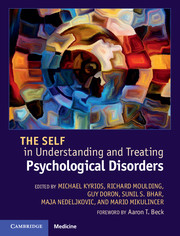Book contents
- The Self in Understanding and Treating Psychological Disorders
- The Self in Understanding and Treating Psychological Disorders
- Copyright page
- Contents
- Contributors
- Foreword
- Acknowledgments
- Section 1 Introduction and concepts
- Section 2 The self in treatment frameworks
- Section 3 The self in specific psychological disorders
- 8 The self in depression
- 9 The self in bipolar disorder
- 10 The self in social anxiety
- 11 The self in posttraumatic stress disorder
- 12 Self processes in obsessive–compulsive disorder
- 13 The self in the obsessive–compulsive-related disorders: hoarding disorder, body dysmorphic disorder, and trichotillomania
- 14 Self-regulation in disordered gambling: a comparison with alcohol and substance use disorders
- 15 The self in autism
- 16 Basic self disturbance in the schizophrenia spectrum: a review and future directions
- 17 Painful incoherence: the self in borderline personality disorder
- 18 The self in obsessive–compulsive personality disorder
- 19 The self in chronic fatigue syndrome
- 20 The self in eating disorders
- 21 The self in dementia
- 22 The self in gender dysphoria: a developmental perspective
- Section 4 Conclusions and future directions
- Index
- References
16 - Basic self disturbance in the schizophrenia spectrum: a review and future directions
from Section 3 - The self in specific psychological disorders
Published online by Cambridge University Press: 05 February 2016
- The Self in Understanding and Treating Psychological Disorders
- The Self in Understanding and Treating Psychological Disorders
- Copyright page
- Contents
- Contributors
- Foreword
- Acknowledgments
- Section 1 Introduction and concepts
- Section 2 The self in treatment frameworks
- Section 3 The self in specific psychological disorders
- 8 The self in depression
- 9 The self in bipolar disorder
- 10 The self in social anxiety
- 11 The self in posttraumatic stress disorder
- 12 Self processes in obsessive–compulsive disorder
- 13 The self in the obsessive–compulsive-related disorders: hoarding disorder, body dysmorphic disorder, and trichotillomania
- 14 Self-regulation in disordered gambling: a comparison with alcohol and substance use disorders
- 15 The self in autism
- 16 Basic self disturbance in the schizophrenia spectrum: a review and future directions
- 17 Painful incoherence: the self in borderline personality disorder
- 18 The self in obsessive–compulsive personality disorder
- 19 The self in chronic fatigue syndrome
- 20 The self in eating disorders
- 21 The self in dementia
- 22 The self in gender dysphoria: a developmental perspective
- Section 4 Conclusions and future directions
- Index
- References
Information
- Type
- Chapter
- Information
- The Self in Understanding and Treating Psychological Disorders , pp. 158 - 168Publisher: Cambridge University PressPrint publication year: 2016
References
Accessibility standard: Unknown
Why this information is here
This section outlines the accessibility features of this content - including support for screen readers, full keyboard navigation and high-contrast display options. This may not be relevant for you.Accessibility Information
- 7
- Cited by
